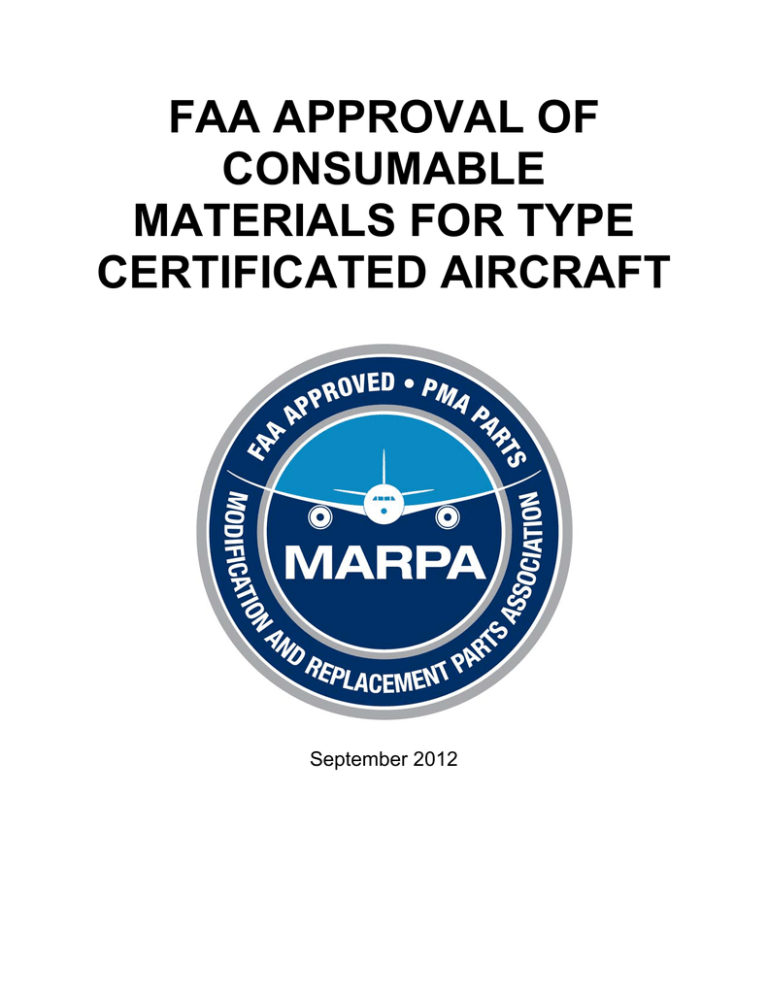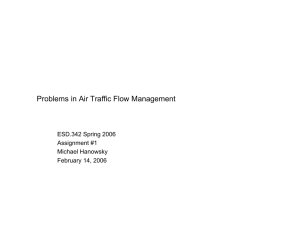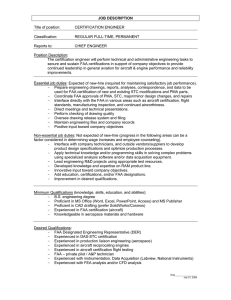FAA Approval of Consumable Materials for Type
advertisement

FAA APPROVAL OF CONSUMABLE MATERIALS FOR TYPE CERTIFICATED AIRCRAFT September 2012 FAA Approval of Consumable Materials for Type Certificated Aircraft Abstract • • • • • • Consumable materials in aircraft must be replenished or replaced at times; Materials that are intended to be installed in type-certificated aircraft, engines or propellers may not be produced unless they are produced according to FAA regulations; The typical method for approving original aviation materials is through the type and production certification (TC/PC) process; A typical method for approving replacement aviation materials is through the parts manufacturing approval (PMA) process; Materials that meet government or established industry specification are considered standards and may not need separate FAA approval; Aftermarket materials, used to replenish or replace consumable materials in an aircraft, that are not standard articles, would typically be approved under a Parts Manufacturer Approval (PMA). Introduction There are a wide variety of consumable materials that are introduced into aircraft, aircraft engines and propellers. The FAA's rules that apply to these materials recently changed, and the purpose of this White paper is to describe some of those changes, and to explore what these changes mean to the aviation industry. The wide variety of consumable materials can be divided two major categories. The first of these two categories is items used in support of type certificated products that do not become part of the aircraft, engine or propeller. This class includes items like solvents, cleaning agents, emery paper, masking tape, and cutting oils. These items are generally used to support and perform maintenance. These items are not part of the aircraft, engine or propeller. In many cases, though, the appropriate material may nonetheless be identified by the design approval holder of the aircraft, engine or propeller. The second category of consumable materials consists of those materials that become part of the aircraft, engine or propeller. Example of these items can include hydraulic fluids, lubricating oils, greases, sealants, adhesives, room temperature vulcanizing silicone compounds, paints, lock-wire, and high temperature tapes. These materials are all consumable items that become part of the aircraft, engine or propeller, and they were part of the type certificated product when the FAA approved the product. Under current regulations, materials that are reasonably likely to be installed on a type certificated product (those that become part of the aircraft, engine or propeller) must be produced under FAA-approval, or they must fit within one of the regulatory exceptions to the approval paradigm. FAA Production Rules for Materials In 2009, the FAA's regulations concerning aircraft parts approval were changed. The new regulations explain that an article that is reasonably likely to be installed on a type certificated product (aircraft, propeller or engine) may not be produced unless it fits into one of six categories: (1) It is produced under a type certificate; (2) It is produced under an FAA production approval; (3) It is a standard part (such as a nut or bolt) manufactured in compliance with a government or established industry specification; (4) It is a commercial part as defined in § 21.1 of this part; (5) It is produced by an owner or operator for maintaining or altering that owner or operator's product; or (6) It is fabricated by an appropriately rated certificate holder with a quality system, and then consumed in a repair or alteration. 1 These six categories tell us that articles must be either FAA approved, or fit into one of the narrowly-defined categories of articles that do not need to be FAA-approved. Before the 2009 change, the range of things that needed to be approved included typecertificated products and parts. Since that change, though, the range of things that need to be FAA-approved has expanded. Under the new rule, the things that need to 1 14 C.F.R. § 21.9(a). be FAA-approved include any article that is reasonably likely to be installed on a type certificated product. The definition of the term "article" is stated in the FAA's regulations: "Article means a material, part, component, process, or appliance." 2 While prior regulations required products and parts to be FAA-approved, the revised regulation requires materials (that are reasonably likely to be installed) to also be approved. The FAA's regulations do not include a definition of the term "install," but the word is derived from the Latin term installare, which meant to place someone in a church position by placing them in the stall associated with the church office. This term has come to mean placing one thing in another thing. Parts are installed in aircraft systems but materials are also installed when they are introduced into an aircraft system. How Can You Legally Produce an Aviation Material? Most materials that are reasonably likely to be installed on a type certificated product will need to be produced according to an FAA approval. The production certificate holder, of course, can approve materials that are found within the scope of the production certificate holder's design and production approval. But most production certificate holders are not in the business of distributing all of the materials that are necessary to keep their products airworthy. As a consequence, it is necessary to find other sources for these materials, and the 2009 change in the rules means that those sources must meet the requirements of the FAA's regulations. The appropriate FAA approval for materials that are not produced by the production certificate holder is usually going to be a PMA. Although the term PMA stands for Parts Manufacturer Approval, the PMA rule has always been available as a source of approval for materials, as well as parts. 3 The PMA regulations repeatedly use the term 2 14 C.F.R. § 21.1(b)(2). Prior to the 2009 change, the applicability clause for the PMA rules in 14 C.F.R. § 21.301 stated "This subpart prescribes procedural requirements for the approval of certain materials, parts, processes, and appliances." The applicability clause was entirely removed from the PMA regulations in the 2009 change, and instead the word "article" is used throughout the PMA subpart in the regulations. 3 "article" as the base unit on which a PMA is issued - this is the term that is defined to include materials. 4 Materials that will be subject to a PMA application are often required to endure the same or greater testing than the FAA required for the certification of the original materials used in the aircraft, engines and propellers. This testing can consist of extreme high and low temperature testing, flammability testing, high-intensity radiated field testing, humidity testing and other tests such as those found in applicable standards. This high degree of testing ensures that the materials will meet the expectations of both the FAA and of the flying public, and that the materials will help to maintain the airworthiness of the complete aircraft. Companies that market materials as suitable for aviation use, when the materials were not produced under an appropriate FAA approval, may be marketing materials that fail to meet the standards of the materials used in the original products. Whether these unapproved articles will fail or not is unknown, but such ambiguity in airworthiness qualities is generally not acceptable in the aviation industry, and it often signals a violation of FAA regulations. Exceptions to the Rules Although aviation materials are usually required to be produced according to an FAA approval, there are a variety of aftermarket aviation materials that would not need to be approved under the PMA process: • • • • • • 4 Materials that are not reasonably likely to be installed on a type certificated product (e.g. materials designed and intended for non-aviation uses); Materials that are not installed (e.g. cleaners and solvents that are used to clean aircraft parts, but that will not be introduced into the type certificated product); Materials that are produced in compliance with a government or established industry specification (i.e. standard materials; e.g. materials produced to AMS, ASTM or MIL standards); Materials that are produced by a Production Certificate (PC) holder; Materials that are produced by a Technical Standard Order Authorization (TSOA) holder; Materials whose production method is approved by the FAA under an alternate approval method. 5 See, e.g., 14 C.F.R. § 21.311 ("The FAA issues a PMA after finding that the applicant complies with the requirements of this subpart and the design complies with the requirements of this chapter applicable to the product on which the article is to be installed"). 5 14 C.F.R. § 21.8(d) permits the FAA to approve any material in any manner approved by the FAA. Within this last category "materials whose production method is approved by the FAA under an alternate approval method," the FAA retains the authority to decide that it can declare anything as "approved" based on any metric that the FAA selects. The FAA also retains the authority to selectively prosecute (or not prosecute) any enforcement action that it chooses, consistent with the FAA's safety obligations and the interests of justice. This discretion is important, because in the real world, there are a great many materials that find their way onto aircraft that are not FAA-approved. In many cases, where these materials were not manufactured with the specific intent that they be placed into aircraft, they were not regulated until the 2009 changes to the manufacturing rules went into effect. Under the new rules, though, if the material is reasonably likely to be installed on a type certificated product then it needs to be FAA-approved or fit into a recognized FAA exception. Many consumables and expendables that have not been FAA-approved in the past will need to be approved under the new regulatory requirements. This is likely to come as a shock to come companies in the industry! Conclusion Consumable materials are articles under the FAA's regulatory definitions. Consumable materials that are created with the reasonable expectation that they may be introduced into a type-certificated product (for example to replace consumable materials that were consumed or otherwise lost from the type-certificated product), are required to be produced under FAA approval or under an explicit exception to the requirements for FAA approval. Forms of production approval that may apply include a PMA or production certificate (including production by a supplier with direct ship approval from the production approval holder). Failure to comply with the FAA regulations may subject the fabricator (and others) to liability under the FAA regulations.



